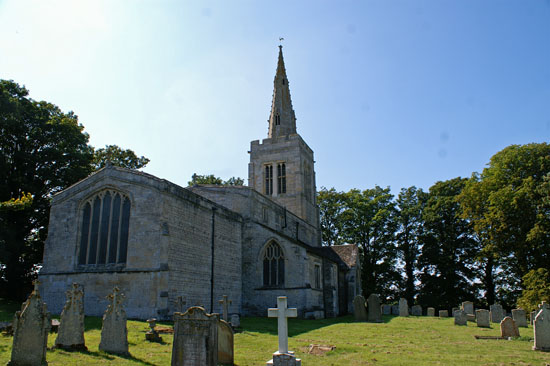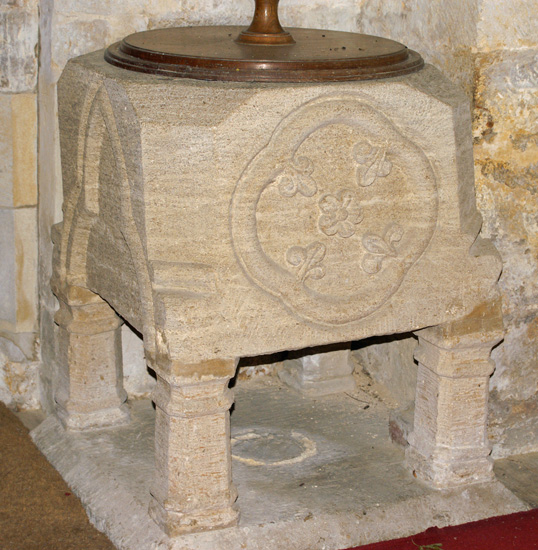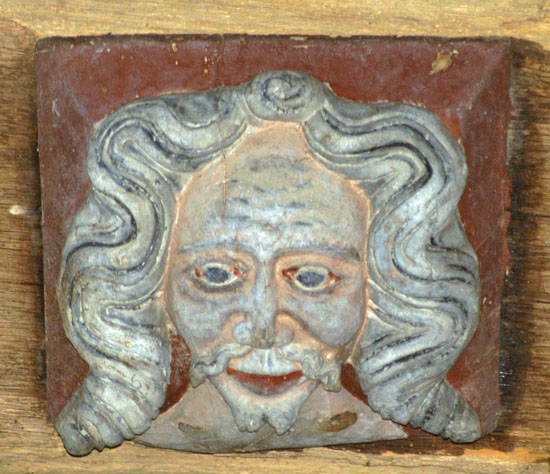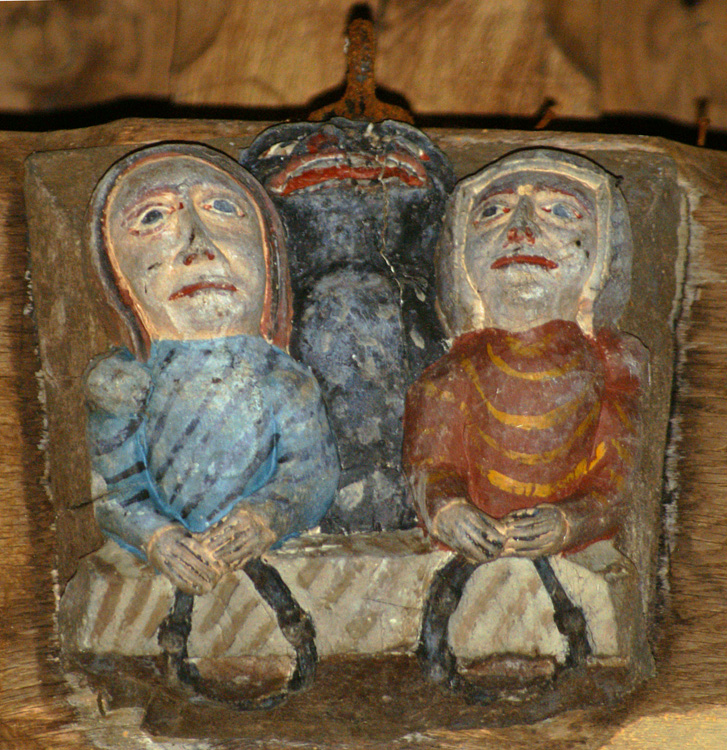|
Alphabetical List |
|
|
|
|
|
|
|
County List and Topics |
|
|
|
Please sign my Guestbook and leave feedback |
|
|
||||||||||||||||||||||||||||
|
an original Norman corbel table (now, sadly, whitewashed!) and Norman string courses. The c13 font is an unusual one. The nave roof was reconstructed in 1737, re-using earlier timbers. It has a remarkable series of wooden bosses that, when photographed using a zoom lens, reveal comic designs, brightly painted. How old these bosses are, I do not know. Both chancel arch capitals are excellent, but it is not stretching it to say that the one on the north side is remarkable. Here we see two mounted knights (although only one horse is visible). To left and right of them are Romanesque buildings - whether it is intended to be one or two is open to question. The Church Guide (following Pevsner) describe this as “two knights and a castle”. This, it seems to me, is breathtakingly simplistic! To start with, the building (or two buildings) do not look like castles at all. To the left we see towers with conical tops. To the right more of the same plus a dome. There is no evidence that they are castles - but whatever they are, they are most certainly NOT representations of anything in Norman England! Norman castles were mainly wooden “motte and bailey” designs and, where they were of stone, they were square as at, for example, the Tower of London. There most certainly was no tradition of domes in Western European architecture at this time. This was the preserve of first the Greeks, then the Romans and latterly the Byzantines. No English builders knew how to build a dome. For more, please follow this link :Early Church Design What we are surely seeing is a representation of Byzantine buildings, perhaps even of the Temple Mount in Jerusalem? So who are the knights? It is likely that they were Crusaders, in my view. The First Crusade was during the period 1096-1099, fitting quite nicely with the early c12 date of the Wakerley nave. Although most of the crusaders departed from France, there was a goodly contingent from Norman Italy. Does the capital owe its design to the accounts of a returning crusader? Even more intriguing is the depiction of two knights and only one horse. This is a symbol of the Knights Templar who were founded in the Holy Land in 1118. There is no known connection between the Templars and Wakerley so perhaps this symbolism was an unconscious one. All this is speculation. Every way you look at it, however, there is much more to this than the Church Guide implies! make up your own minds. Despite the changes, the restorations and the preservations, Wakerley Church is still pleasantly proportioned and satisfying aesthetically. For its collection of unusual features and, in particular, its chancel arch capitals it is a little gem. |
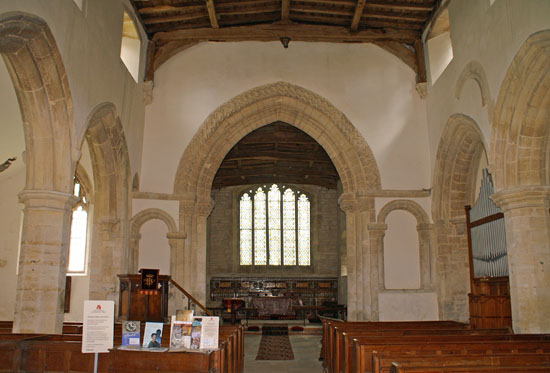 |
 |
|||||
|
Left: Looking towards the east. The chancel arch is clearly rebuilt from the original Norman. Note the blank Norman niches to either side of it. Right: The shallow c15 chancel with Perpendicular east Window |
||||||
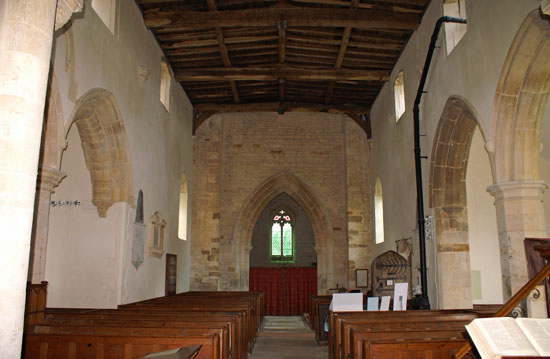 |
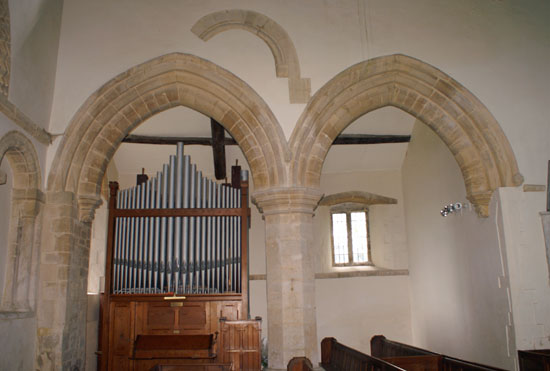 |
|||||
|
Left: Looking towards the West end. The south arcade is c14, the north is c15. Right: Small two bay arcades lead to the side chapels. Note the filled in Norman archway. This is slightly intriguing. It’s surely too small to be an arcade opening, yet at the wrong height to be a window opening, I would have thought. |
|
|
||||||||||||||||||||||||||||||||||||||||||||||||||||||||||||||||
|
The late c13 font is carved from a massive block. I suppose that it is not unusual for fonts to be unusual (!) but this one is...well...unusual! There is none of the frequent crudeness or occasional magnificent flamboyance of a Norman font; yet also it does not have the well-mannered style of a later gothic font. |
|
|
|||||||||||||||||||||||||||||||||||
|
The other two above are anybody’s guess! On the left hand carving the two people seem to be carrying whips - or are they fetters? - while a black creature looks over their shoulders. On the right is a downright weird image of another black creature with striped fur - or else a black man in strange clothes. In both cases the figures seem to be standing beyond a table of some sort. I speculated rather fancifully that they look like characters from a mediaeval puppet show or drama. There is, after all, a playful air about these carvings. Alan Murray-Rust believes the left hand picture depicts Adam & Eve with the Devil. But he can’t explain those things in their hands either. Whips are a symbol of penance so that’s just about consistent with Alan’s theory. You might think, as I do, that it would be odd to depict Adam & Eve in contemporary costumes. So perhaps these are good old fashioned everyday sinners? You know, like you and me? The bosses are undated by the Church Guide which points out that the roof was reconstructed in 1737. “Eve’s” headdress, however, is of a distinctive “gabled” style so I think fifteenth century is a pretty accurate estimate. |
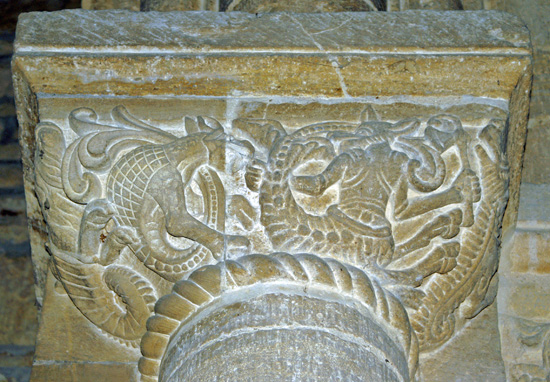 |
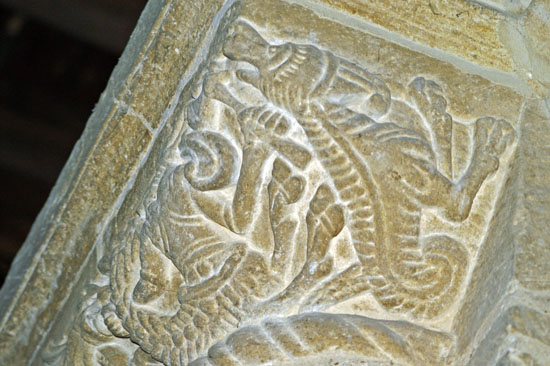 |
|
Left: And so to those spectacular Norman chancel arch capitals. This is the south side and it is truly magnificent. This picture is of the south aspect (ie on the underside the arch). The creature on the right is wielding an axe, He has cloven hooves and the head of what is maybe a dog or jackal. His body and arms are human. His left hand holds his long scaly tail. To his right are two hooved legs. This really is the ultimate composite animal/human figure. Facing him is a wingless dragon. Right: Monsters flank the main scene. This is the one on the west side. Again, the character is a strange mixture and his head seems to be baying at the sky. What is this about? Well don’t get me going by talking about the “struggle between good and evil” PLEASE! This is not a Christian allegory at all, of that I’m sure. The axe-wielding beast is as finely depicted as any fantastic beast you are going to see in an English church. I’m convinced that the artist knew exactly what he was doing and that this is not some random fantasy scene. If pushed I would be thinking of scenes from Norse mythology but I can’t identify the characters nor find any supporting evidence. The plethora of monsters makes me think of Ragnorok - the Norse equivalent of the Apocalypse where the gods fight each other to the death. Northamptonshire was part of the Anglo-Saxon kingdom of Mercia but Mercia was conquered by the Vikings in AD874 and there is much evidence of this in the local place names. So who knows? Many experts believe that the capitals here were from the same masons or workshop that created the capitals at Castor in Cambridgeshire so you might want to check that out. Others link it to the carver of the Priors Doorway at Ely in about 1140. Note that the dog-headed figure is grasping the tongue of the dragon. In mediaeval mythology the tongue was regarded as the seat of a dragon’s power and it seems that this dragon’s attacker was seeking to cut it out. |
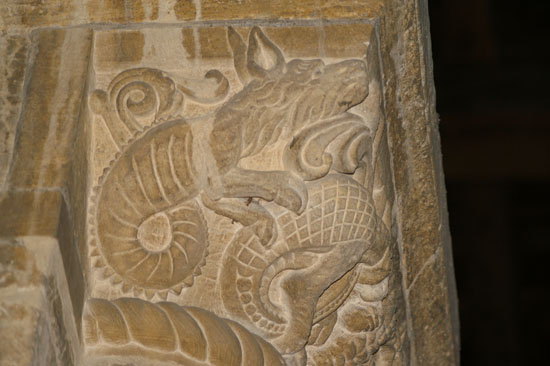 |
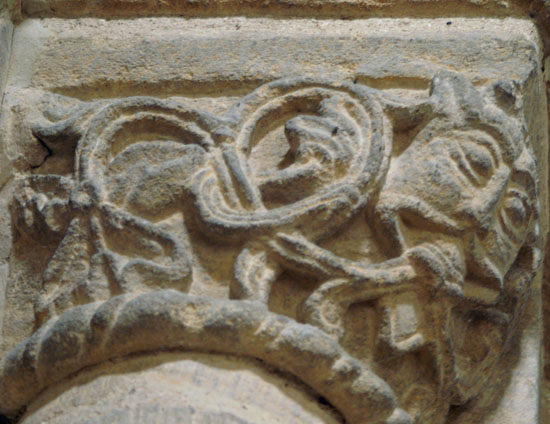 |
||||||||||||||||||||||||||
|
Left: The final piece of the apocalyptic scene on the eastern respond is this creature with a dog-like face, boar-like ears and a segmented tail complete with protruding scales! Right: The half-pier on the south side has this image of inter-twined foliage spewing from the mouth of a cat or a lion. |
|||||||||||||||||||||||||||
 |
|||||||||||||||||||||||||||
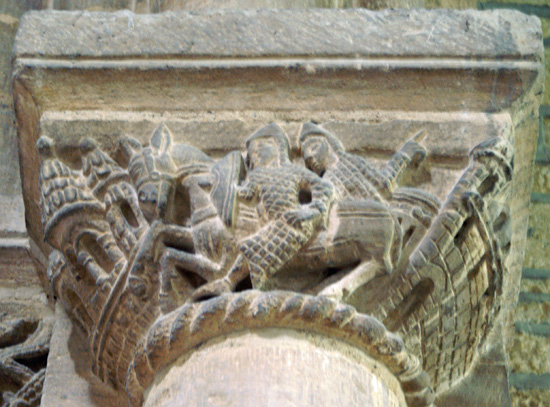 |
|||||||||||||||||||||||||||
|
Left: The lion’s face. Right: And so to the exciting chancel arch north capital. Two knights in chain mail and Norman-style helmets, one with a shield, and with one horse between them are flanked by two Byzantine-style buildings - or one, depending on your view. |
|||||||||||||||||||||||||||
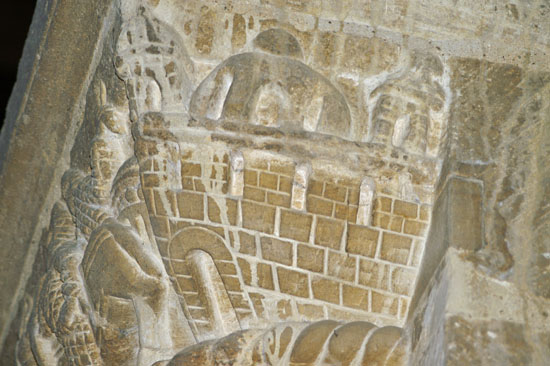 |
|||||||||||||||||||||||||||
 |
|||||||||||||||||||||||||||
|
Left: This building on the west side of the capital shows three conical turrets, each with double windows or bell openings. Pevsner is surely wrong in saying that this is one half of a single castle. Castles of the day would never had windows of this sort to weaken their structures. A temple is more likely. Right: The northern side is more like a castle - but that’s not saying much! There are still windowed turrets and even a central dome. There is nothing to connect it to the south side or to suggest that there is only one building. Interestingly too, the knight on the right is pointing backwards seemingly towards this building - but who knows what was in the mind of the carver? |
|||||||||||||||||||||||||||
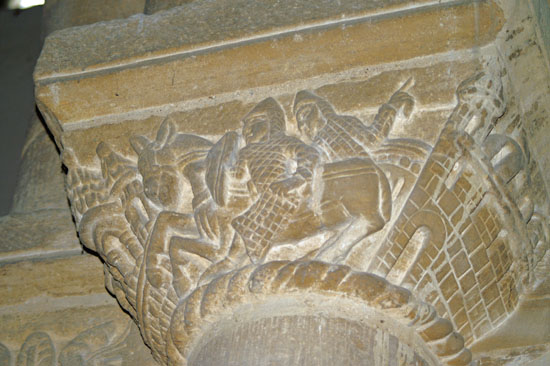 |
|||||||||||||||||||||||||||
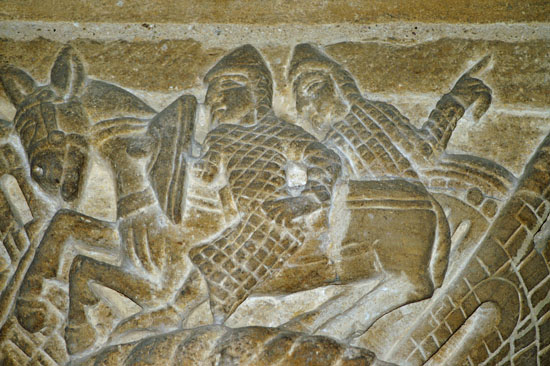 |
|||||||||||||||||||||||||||
|
A closer look at the mounted knights. Note that the horse’s harness is visible, as are reins and even a shield boss. You can only see one horse in this scene so I have speculated that this is a “two knights on one horse” motif of the Knights Templar. There are two problems with the this theory: firstly that the second knight is not shown astride the horse when it seems it would have been relatively easy to have depicted him thus. Secondly that we know of no Templar connection with Wakerley. The nearest preceptory was at South Witham about eighteen miles north and it wasn’t founded until 1164. That does not mean that there were no Templar lands in Wakerley, but if there were then I can find no record. In terms of chronology it would be a marginal call to say the least. The First Crusade was 1096-9 and resulted in the capture of Jerusalem. The usual date postulated for this church is around 1120. To be celebrating the recapture of Jerusalem in a church at this time would seem to me to be extremely plausible. I can’t over-emphasise my conviction that the buildings depicted here are NOT western architecture. I am convinced in my own mind that this carving depicts the First Crusade. The Knights Templar, however, were founded by Hugue de Payens in 1119 and were granted space in the Al Aqsa Mosque on Temple Mount in Jerusalem giving the Templars their name. I would go so far as to suggest that the domed building in this scene might be a representation of the Dome of the Rock itself. If the church was indeed built in 1120 then I would suggest that the Templars would not have been sufficiently well known then for a carving here to be plausible. If it was later and by the man who carved the Priors Door at Ely then it becomes a bit more plausible. Putting all this together I am doubtful about a Templar connection - I am sad to say! |
|||||||||||||||||||||||||||
|
Just a final word on these carved capitals. First of all, they are much more ambitious than those at Castor. So much so that it hard, in my view, to equate them. Cleverer people than myself, however, feel able to make a connection so I’m not about to argue. The dog-headed figure on the south capital resembles a jackal. The ears are long and the jaws pronounced. It might not be a dog at all! Anyway I will leave you to decide whether the jackal head at Wakerley matches the one pictured below at Castor. |
|||||||||||||||||||||||||||
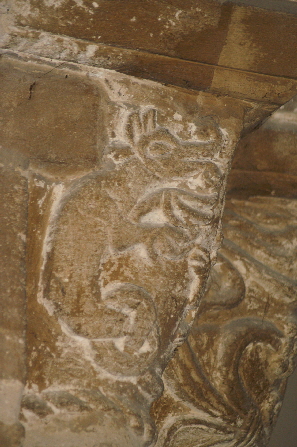 |
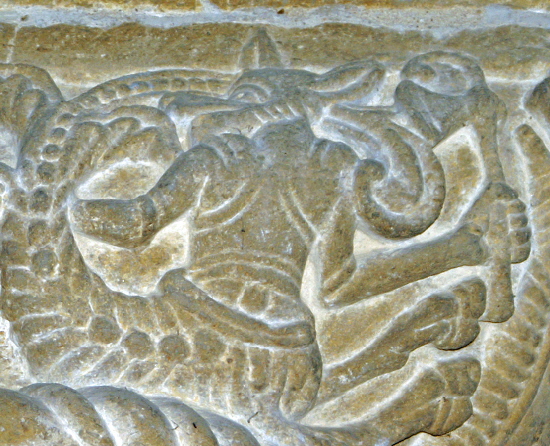 |
||||||||||||||||||||||||||
|
Jackal/Dog heads at (left) Castor and (right) Wakerley. |
|||||||||||||||||||||||||||
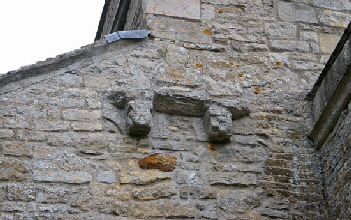 |
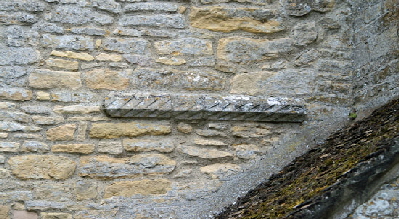 |
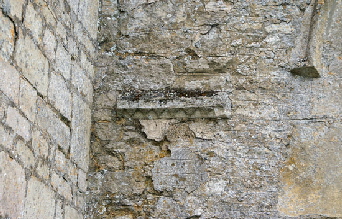 |
|||||||||||||||||||||||||
|
Remnants of Norman string courses and corbels on the exterior of the church. |
|||||||||||||||||||||||||||
|
|
|||||||||||||||||||||||||||
